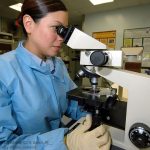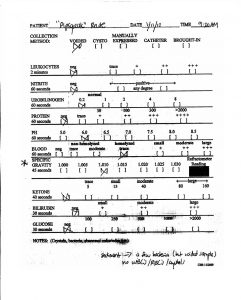Please Explain My Dog Or My Cat’s Urine Urinalysis Results
Ron Hines DVM PhD
 See What Normal Blood & Urine Values Are
See What Normal Blood & Urine Values Are
 Causes Of Most Abnormal Blood & Urine Tests
Causes Of Most Abnormal Blood & Urine Tests
Your Dog Or Your Cat’s Urinalysis Results
Checking your pet’s urine for its characteristics and the presence of things that should or should not be there, along with a CBC/ WBC and blood chemistry determinations, form one of the four pillars of veterinary diagnosis. The other three are the medical history of your pet that you provide, your veterinarian’s physical exam and any diagnostic imaging (x-rays, ultrasound, etc.) that might be indicated.
A complete urinalysis is something that your veterinarian’s technicians are often trained to perform in their office. It is quick and relatively inexpensive. It provides a wealth of information about the status of your pet’s urinary tract, and frequently clues to many other important health issues that might be occurring in your pet’s body. Besides determining the chemical characteristics of your pet’s urine, a complete urinalysis includes a microscopic examination for the presence of red blood cells, white blood cells bacteria, crystals, or debris.
Your veterinarian gets the most accurate mental picture of your dog or cat’s health situation when the results of your pet’s CBC/WBC and blood chemistry are in one hand and the urinalysis results in the other. Important information can be missed or misinterpreted when the two are not performed together.
A complete urinalysis begins with a fresh urine sample. Stale or contaminated samples give misleading results.
The first exam is a visual and sniff test. Urine color, turbidity, and odor are important.
The next step is to determine the urine’s concentration or specific gravity(SpGr). The specific gravity of your cat or dog’s urine is an indication of both kidney condition and body hydration. Your veterinarian uses a small optical apparatus called a refractometer to determine your pet’s urine specific gravity.
Then a urine ‘dipstick’ – a thin strip of paper impregnated with various chemical-containing squares – is moistened with urine. Depending on the color change of specific squares, up to ten urine parameters can be checked: glucose, bilirubin, ketones, specific gravity, blood, pH, protein, urobilinogen, nitrite, and leukocytes. Those values provide information regarding the pet’s blood sugar status, kidney and liver function, acid-base balance, and possible urinary tract infection or other urinary tract disease.
Once that has been done, a tube of your pet’s urine is centrifuged to drive suspended particles to the bottom. That sediment is removed and examined under a microscope for the presence of crystals, white or red blood cells, bacteria, possible tumor cells or the cast remnants of cells that should normally line the urinary tract system. You can read about the reasons these elements might be found through each of the ten links in the paragraph above.
When your veterinarian suspects a urinary tract infection and wishes to culture your dog or cat’s urine for bacteria, she/he often prefers a non-contaminated sample obtained through a needle. The procedure is called cystocentesis. Urine that is voided always contains a few bacteria. Traditionally, veterinarians and physicians believed that urine collected by cystocentesis should never contain any bacteria. However, some of the extremely fragile and difficult-to-identify bacterial inhabitants of the urinary tract might actually be beneficial. (read here)
DxMe
 Dear reader, Besides your donations, Visiting the products that Google chooses to display on this webpage helps me pay the cost of keeping this article on the Web. As you know, sites like mine that are not designed to make money are getting harder and harder to find. Best wishes, Ron Hines
Dear reader, Besides your donations, Visiting the products that Google chooses to display on this webpage helps me pay the cost of keeping this article on the Web. As you know, sites like mine that are not designed to make money are getting harder and harder to find. Best wishes, Ron Hines




